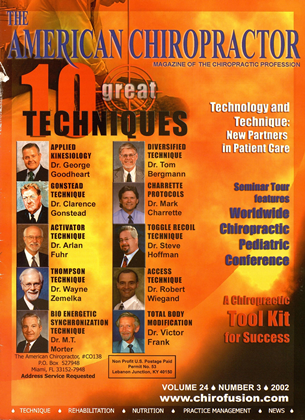Is conventional radiography going to become a thing of the past with the adjunct of digital imaging, or may we somehow always use this technology? .] A: The use of plain film radiographs has been, and is likely to remain, the mainstay for chiropractic imaging in the general practice. Since, I believe, there will be a movement to digital imaging, the standard X-ray tube and table installation will be maintained; however, the darkroom, processing and the method of viewing and archiving of films will change. In order to implement a digital imaging system, the chiropractor's X-ray machine need not be replaced, nor do the cassettes or screens need to be replaced. A phosphorous plate is placed within the X-ray cassette, eliminating the need for film and for the film to be processed in the darkroom. This phosphorous plate is then sent through a scanning device where the images are captured and transmitted to a computer disk for final display and interpretation. If the chiropractor wishes to have a printout of the image, this can be performed on paper or film for a hardcopy to be given to the patient or placed in their file. The images can also be transmitted via the internet or broadband lines to referral sources, for second opinions, to other practice locations and/or the chiropractor's home office. Q: Are the digital systems manufactured today compatible with old single-phase X-ray machines or the newer X-ray high-frequency systems? A: Digital radiography systems arc compatible with all these systems. Whether the chiropractic X-ray suite is fitted with single or 3-phasc generators, or high frequency systems, digital imaging produces excellent images, which can be mag-nified, zoomed, windowed and leveled; and the need for retakes because of poor technique is eliminated. The inherent advantages of a digital system arc applicable with all these systems. Q: When should I consider going with a stored energy system with my new X-ray machine, and what are the advantages and disadvantages? A: When a radiographic room is laid out, the electrical power becomes a very important issue to consider. In some cases. there is enough power in the electrical panel to run a 220-volt. 100-amp dedicated system: often, there isn't. However, more and more in today's office suites, the power provided is simply not adequate to drive the high frequency system. Therefore, the leasee is responsible for "upgrad- ing" the incoming power. At this point, the issue can become an economic consideration. There are several reasons why one may or may not want to incur the additional cost of upgrading the existing power or upgrading the system to a stored energy system. 1. The cost to bring in the required power can sometimes be very high; i.e., % 1,000 to S2,500, and, in some cases, even more. If the doctor has agreed to lease the site for only thrcc-to-five years, he/she should then consider paying the additional fee to upgrade the X-ray equipment to a Stored Energy system, rather then doing the electrical work. The fee for a stored energy system is usually around $ 1,500 to $2,300. But, the system can easily be removed, so that investment can be taken with the doctor upon moving to a new location. This eliminates leaving the electrical power behind for the next occupant to use. This is a great advantage when moving to the new location, as the system would just plug right in 110 volts at the new site. 2. The battery life has always been a great concern when factoring the overall expense of going with a Stored Energy (S.E.) system. The life expectancy of the batteries is anywhere from 7-to-10 years and costs approximately $1,700 to $2,500, depending on the amount of labor and travel time incurred in doing the job. 3. The new S.E. generators that are being produced operate at 100kHz and are offered as true 30-KW-rated systems, thus eliminating the issue of losing any penetration and/ or power to be utilized on larger patients. 4. S.E. generators are more isolated from the power line, making them less susceptible to surges and storm related power problems. Dr. Terry R. Yocluun is a second-generation chiropractor and a cum laude graduate of the National College of Chiropractic, where he subsequently completed his radiology specialty. He is currently Director of the Rocky Mountain Chiropractic Radiological Center, in Denver, CO, an Adjunct Professor of Radiology at the Los Angeles College of Chiropractic. Dr. Yoclium is a consultant to a company called Virtu-Rad that deals with digital imaging, and Healthcare Manufacturing, that offers a stored energy system. For more information, Dr. Yochum can be reached at: (303) 940-9400 or by e-mail at: dcrad099(a)aoicom. Ed Editor's Note: If you have any questions about X-ray technology, faxorleavea voice mail at 1-305-716-9212. ore-mail Jaclyn^wnchiropraslaLcam,
 View Full Issue
View Full Issue









